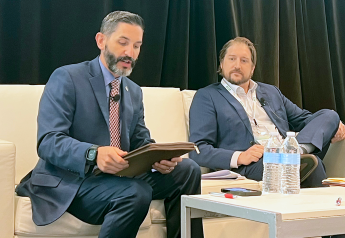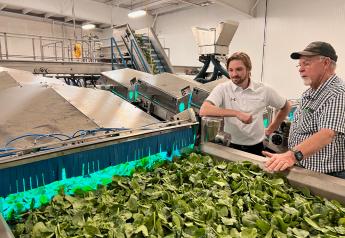Whether a scourge or an answered prayer, a surge in reported food safety outbreaks has already begun.
As far as numbers are concerned, expect that surge to grow to tidal wave proportions.
The use of whole genome sequencing to detect strains of pathogens is a major factor causing the surge, said Martin Wiedmann, a food safety professor for Cornell University, Ithaca, N.Y.
The starting place for using whole genome sequencing has been detection of Listeria monocytogenes. The industry already has seen the early effects in the reported listeria outbreaks at a major company's packaged salad processing plant early this year and in caramel apples last year.
"Based on data for Listeria monocytogenes, we have seen a 50- to 100-fold improvement in the ability detect listeriosis outbreak," Wiedmann said.
Plans call for expanding the use of whole genome sequencing beyond listeria to all types of pathogens.
"Continued improvement in the ability to detect foodborne disease outbreaks is very likely," Wiedmann said.
Whole genome sequencing is a game changer for these reasons:
- it is making correlations not possible before, even spanning many years;
- its data is much more detailed;
- it is finding problems not suspected before; and
- it is doing it faster than before.
The kicker is that the cost of whole genome sequencing is coming down, thanks largely to the push to cost-effectively map human genomes. Pathogen genomes are much less complex and cheaper to map because of the development and commercial introduction of new rapid-sequencing methods.
Sequencing a bacterial genome can cost as little as $50 per isolate and be done in less than five days, Wiedmann said in late June at the Center for Produce Safety Research Symposium in Seattle.
However, at this point, to get the cost down so far, large numbers of isolates must be batched at the same time. That means government entities can better use the technology than companies.
That may change, though. It may become cost-effective sooner rather than later.
"My understanding, and from talking to labs, is (whole genome sequencing) is coming, and it's coming soon," said Drew McDonald, vice president for food safety for Salinas, Calif.-based Church Brothers Farms and True Leaf Farms.
Could have saved $100 million
The goal is to detect outbreaks earlier, before problems become widespread.
For instance, consider what would have happened if whole genome sequencing had been available in 2008, when Florida fresh tomatoes were initially blamed as the source of a salmonella outbreak but later Mexican jalapeño and serrano peppers were determined to be the source.
That determination took weeks. Florida fresh tomato sales tanked. However, if a tool like whole genome sequencing was available, things might have been different.
"It would have saved us over $100 million," said Reggie Brown, executive vice president of the Florida Tomato Exchange, Maitland.
In his opinion, the use of whole genome sequencing seems to be a step in the right direction for a couple of reasons.
First, it will help the FDA from misidentifying or making pronouncements based on gross assumptions, which is how Florida's tomatoes caught blame.
Second, "there will be hard, undeniable facts to present to producers, none of whom think their products or facilities could be a source of problems," he said.
The Florida tomato industry paid the tab for a very expensive lesson learned, he said, though the FDA seems to have amended its ways, and the use of whole genome sequencing is part of the changes.
"I think they are much more precise and much more careful in naming a product or an industry as a result of a food safety outbreak," Brown said.
Plugged into PulseNet
Whole genome sequencing is being plugged into PulseNet, a national laboratory network run by the Centers for Disease Control and Prevention that connects foodborne illnesses to detect outbreaks.
PulseNet's name comes from the process being supplanted by whole genome sequencing. PulseNet was created in 1996, when the focus was on E. coli O157:H7 initially but broadened to include other pathogens. It manages a database of DNA "fingerprints" to check samples against.
Recently, the focus of outbreak detection has been on L. monocytogenes. In 2013, the Centers for Disease Control and Prevention began a one-year project to apply whole genome sequencing to L. monocytogenes. The Food and Drug Administration and the U.S. Department of Agriculture were partners in the project.
Though listeria was a good place to start because of the relatively small number of cases among people and the small, easy-to-sequence genome, the listeria-centric focus won't last, Wiedmann said. By as early as 2018 whole genome sequencing will supplant the previous technique complete, he said.
Salmonella, in particular, is getting the whole genome sequencing treatment, he said.Salmonella is blamed in 1 million U.S. foodborne illnesses, causing 19,000 hospitalizations and 380 deaths, according to the CDC. For comparison, about 1,600 illnesses and 260 deaths are caused by listeriosis annually in the U.S.
Scary technology
The new techonology will bring surprises, and many find surprises unsettling.
"I am anticipating that before too long there are going to be situations where illnesses will be linked through (whole genome sequencing), but the actual source or sources will be confusing as seemingly unrelated sources will emerge," McDonald said.
The new technology can be scary, largely because protocols for performing the tests and using the data have not been fully established, he said.
"Here we have a fantastic and powerful new tool, but how best to use it still needs to be worked out," McDonald said.
Whole genome sequencing will produce surprising results and connect seemingly unrelated sources of pathogens.
"Companies will be surprised if they are not paying attention to what is happening around them right now, today," he said.
From his point of view, the problem with whole genome sequencing or any testing is that it always looks behind. The goal has to be to identify potential problems and prevent them.
"If (whole genome sequencing) allows us to better determine (the) source, and we learn from these events, then we can review our practices, equipment and operating conditions to truly reduce the likelihood of these cross-contamination events," McDonald said.
What's your take? Leave a comment and tell us your opinion.








